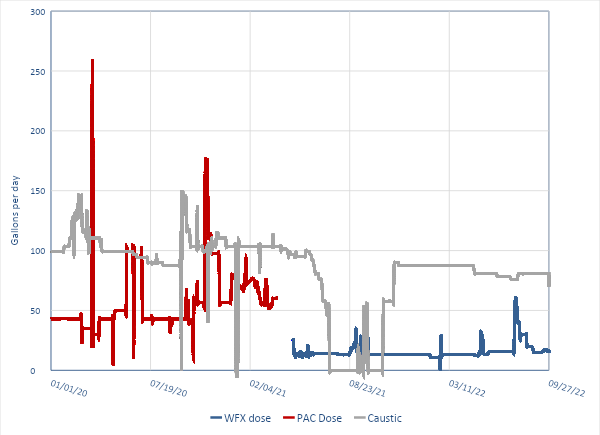
City of Dallas WWTP chemical feeds 2020-2022, using PAC and then switching to WaterFX.
We have focused several articles showing the benefits of switching to Neo WaterFX from “traditional” coagulants for phosphorus removal in wastewater. By “traditional”, we usually mean ferric chloride or alum.
But what about specialized coagulants like Poly Aluminum Chloride, abbreviated PAC or PACL? Can switching to WaterFX provide benefits over PAC? That was the question Dallas, GA had when they investigated switching and evaluated the theoretical benefits prior to engaging Neo Water Treatment for a pilot study in 2021. After a couple of months of testing, they had confirmed the benefits and made the switch permanent.
Total Phosphorus Effluent Limit of 1 mg/L
The wastewater treatment plant for the City of Dallas, Georgia has primary treatment as well as secondary activated sludge and tertiary cloth filters. Its current design capacity is 3 million gallons per day (MGD). In 2020, the average daily flow was just under half capacity at 1.4 MGD. The plant personnel had used PAC, at a dose of 45-65 gallons per day, to keep the total phosphorus (TP) between 0.5 and 0.8 mg/L, well under the 1.0 mg/L limit. But they were concerned over the amount of chemical sludge produced as well as the alkalinity that the PAC consumed and the operational difficulties they encountered with using PAC in winter. They were looking for a better solution.
WaterFX Delivered Operational Advantages and Bottom-Line Benefits.
In May 2021, the WWTP staff began using WaterFX and stopped dosing with PAC. WaterFX maintained the plant in full compliance with their TP limit from the very first day and within a few days, the plant lined out with a TP of 0.5 mg/L.
Soon they began to notice other benefits. The alkalinity was less impacted, allowing them to cut back their caustic feed by 25%. The WaterFX dosage was steady at only 16 gallons per day, rather than the 40-60 gallons of PAC. Combined, the chemical savings are estimated to be $10,000 per year.
Due to the lower chemical feed, less chemical sludge is produced using WaterFX. In addition, the sludge produced dewatered more readily, allowing them to produce a drier cake, and dispose of less sludge overall. It is estimated that the cost savings from sludge disposal are approximately $40,000 per year.
Operational Benefits Did Not Stop With the Lower Chemical Feeds and More Stable Alkalinity.
As the summer progressed, the operators noticed that they had far less algae developing in the clarifiers. Because WaterFX binds tightly with phosphorus, it does not release it as other coagulants are prone to do under low oxygen conditions, as may develop in clarifiers. Less algae meant less time cleaning the clarifiers, saving time, money and frankly, aggravation.
The summer wasn’t the only time that saw these ease of operation benefits. Winter brings special challenges to dosing with PAC, which can thicken and gel at 35°F, making it challenging to pump, and requiring heated tanks and piping. WaterFX is stable and fully liquid down to -40°F, making heat tracing of tanks and pipes unnecessary, and giving one less thing to worry about during cold snaps. It also provides added assurance that the phosphorus limit will be met regardless of the unexpected temperature changes. Peace of mind. That is a very real benefit.
Download the City of Dallas Case Study to get the whole story.
What started with an evaluation led to a study and a permanent switch for the City of Dallas.
If you would like to check out these benefits for your WWTP, contact us for a free evaluation. Our engineers can help determine if WaterFX can save you money while improving your operations, just like they did for the City of Dallas.



